Review: Nokia N800 Internet Tablet (Part 2)
Picking up where we left off . . .
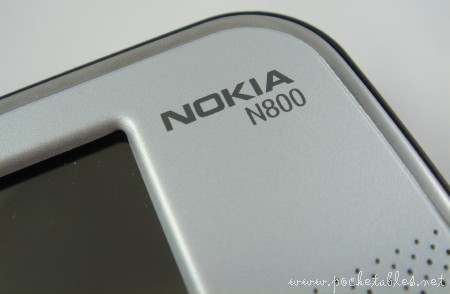
Now let’s take a look at the Nokia N800’s internet capabilities, communication features, multimedia functions, productivity options, comfort and ergonomics, and battery life.
Feel free to revisit Part 1 if you need a refresher on where we’ve been or simply join me for Part 2 below.
Internet
Although the N800 is capable of a lot more, its main feature is the internet. The device offers rich web browsing on a high-resolution display, Flash 9 support (yes, that means YouTube), and near-instant connectivity through a Bluetooth-enabled cell phone or 802.11b/g wireless network.
Truth be told, unless your lineage traces back to Linux folk, one of the most compelling reasons to buy the N800 is to hop online and surf to your heart’s content.
Setting up a connection
The "Connectivity" section in the Control Panel has everything you need to get online.

Just tap the "Phone" icon to set up a Bluetooth DUN connection with a compatible cell phone, or hit "Connectivity" to create and define wi-fi connections. The system will present you with a series of windows and on-screen instructions that make the process simple and fast.
Getting online
Once connected—and it really only takes a moment—just tap the world icon in the task navigator and select "Open new browser window" or a bookmark.
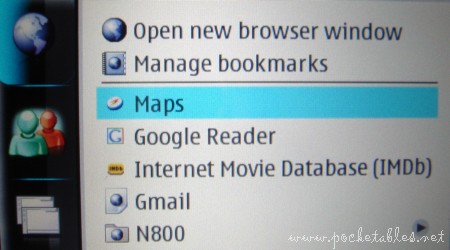
That’s it. You’re online.
Alternatively, you can also 1) tap the applications icon in the task navigator and choose "Web" from the menu or 2) select the "Web shortcut" or "Internet search" applet from the device’s home menu.
Browsing the web
The Opera 8 web browser comes preloaded on the Nokia N800.

Opera is definitely one of the better browsers currently available for portable gadgets (excluding the iPhone). It’s full-featured (bookmarks, multiple windows, Flash, etc.) and renders web pages relatively quickly and in their true desktop form. An optimized-view mode is included on the N800, but the native 800 x 480 resolution makes the option more of a nicety than a necessity.
Even though Opera is quite capable as far as mobile browsers are concerned, it crashed several times on my first day of using it and doesn’t know how to render this site correctly. Text spacing also seems a bit off, and it also usually chokes on Google Reader and Gmail, which I use several times daily. Because of this, it didn’t take long before I sought out a few browser alternatives.

My favorite of what’s currently available is the Mozilla-based browser that was released about a month ago. It’s still in beta so a few bugs have yet to be shaken out, but it has full AJAX and Google Reader works without a hitch. No other mobile device I’ve tried (excluding UMPCs, of course) has ever been able to keep up with the full version of Google Reader, so I am completely enamored with Mozilla.
Here’s a comparison chart of load times (in minute:second format) I put together while working on my "Website load times on portable gadgets" review from the other day.
| |
Mozilla browser (beta release) |
Opera 8 (default browser) |
| Amazon | 0:19 | 0:16 |
| CNET | 0:30 | 0:27 |
| Digg | 0:19 | 0:16 |
| Engadget | 0:46 | 0:23 |
| Google News | 0:09 | 0:08 |
| Micro PC Talk | 0:18 | 0:15 |
| MySpace | 0:14 | 0:12 |
| NY Times | 0:31 | 0:26 |
| Pocketables | 0:23 | 0:18 |
| YouTube | 0:18 | 0:15 |
As you can see, browsing speed in Mozilla is generally a few seconds behind Opera (not sure what’s going on with Engadget), but I don’t care. Google Reader, Gmail, and this site rendered correctly are worth the extra wait.
The N800’s hardware controls (discussed in Part 1 of the review) can be used for navigation and scrolling, but as I mentioned earlier, I find most of them too clunky. I rely on the touchscreen instead.

The toolbar at the bottom of the browser makes it easy to get around the web using the included stylus or a fingertip (your own, preferably).
The hardware buttons I do use all the time are the ones located at the top of the device: the dedicated zoom and full-screen keys.
A quick press of the full-screen key lets me go from this:
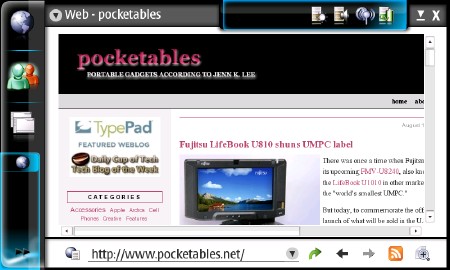
To this (with the toolbar):

Or this (without the toolbar):

If any of the text is too small to read, I press the zoom keys at the top of the N800 or bring up the menu in the toolbar.
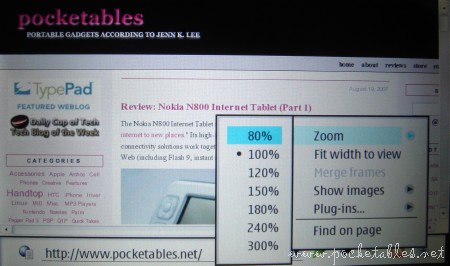
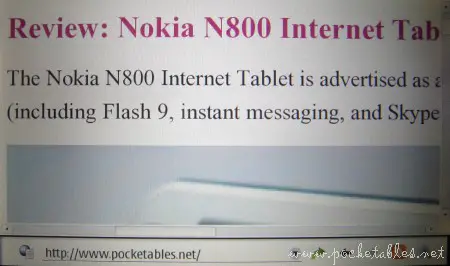
A page can be zoomed in 7 intervals, from 80% to a rather outrageous 300% (shown in the photo directly above).
YouTube
I’m not much of a fan myself, but I know that YouTube support is high on the list of many people’s must-have features of any mobile web experience. That’s why it’s getting its own section.

As one of the only portable gadgets around that can even play YouTube and other online video, the N800 is already a step ahead of a lot of other devices. Playback is a bit choppy while the video is downloading, but after that it’s not too bad. In other words, the bar isn’t set very high. Once Flash support on handhelds becomes the norm, I don’t think the N800’s YouTube abilities will be looked upon too favorably.
Communication
Nokia is better known for their vast array of mobile phones than their internet tablets and GPS units, so a common (and reasonable) assumption about the N800 is that it’s a phone.
It isn’t.
But that doesn’t mean it can’t be used to stay connected with friends and family. Quite the contrary! The Nokia N800 is actually quite the internet-based communicator.
Instant messaging

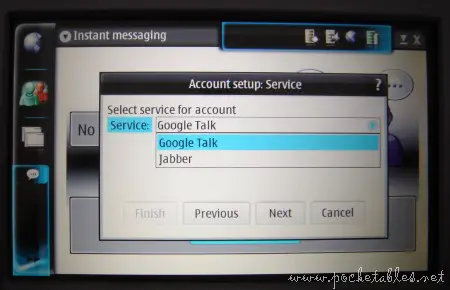
First of all, it’s got instant messaging. Google Talk and Jabber both come preinstalled on the unit, but don’t forget about all those third-party applications, notably Pidgin On Maemo, to keep your thumbs moving and the stylus tapping.
Internet calling & Skype
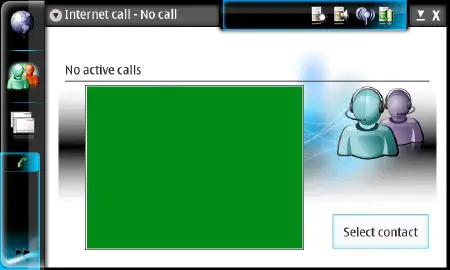
The N800 also supports internet calls (VoIP) with video through Google Talk and Jabber. I didn’t test out either service because the day before I unboxed my N800, Nokia released a firmware update (version 4.2007.26-8) that added native Skype support.
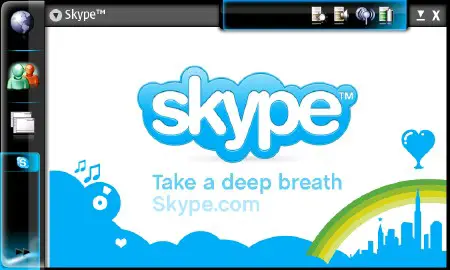
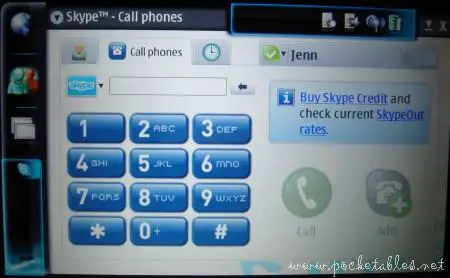
Video chatting isn’t supported yet, but everything else is pretty spot-on with the desktop version.

Well, almost everything.
Call quality was horrible on my end using the supplied stereo headset (barely audible, delayed sound, echo, the works), but those on the other end reported clear landline-esque sound. I put the headset back in the box (where it will stay) and have been using my Sennheiser CX300S inner-ear monitors and the N800’s built-in microphone with better results.
The mic is very sensitive, which is good because you don’t have to hold the device up to your mouth, but bad because it picks up a lot of background noise. A few people I called (from home) said it sounded like I was standing in the middle of a freeway! Ironically, they sounded better and clearer to me.
Call volume is generally pretty low through the built-in stereo speakers and headphones, but maxing out the system volume makes it a non-issue, assuming that you remember to decrease it before you listen to music or watch a movie, of course.
Since I’ve never been all that interested in instant messaging and I really only signed up with Skype for testing purposes, it should come as no surprise that my preferred method of online communication is email.
The N800 has an email client that supports both IMAP4 and POP3 accounts. I already set up five accounts on my iPhone, which I take with me when I leave the house, so I only set up one on the N800 (I don’t think there’s a mailbox limit). The process was pretty standard (account type, personal info, server settings, etc.) and only took about a minute to get through.
Here’s a shot of the inbox:
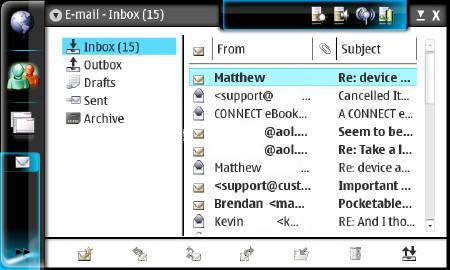
And here’s an email:

Nothing fancy. Just functional with a nice mix of basic and advanced settings (delete messages from server, retrieval intervals, message size limits, HTML or plain text, SMTP authentication, digital signatures, read receipt, and so on).
Multimedia
Because both expansion slots each support up to 8GB cards (SD, miniSD, microSD, MMC, RS-MMC), the Nokia N800 can easily transform into a formidable 16GB flash-based portable media player boasting a large widescreen display and a well-rounded set of compatible photo, audio, and video formats (see specs chart in Part 1 for details).
Media player

Preloaded onto the N800 is a media player application uninspiringly named Media Player. Better apps from Linux developers are freely available online (not to mention downloadable and installable directly on the device), but if all you want is a no-frills program to watch an occasional movie or listen to music, Media Player is fine.
Video playback is good and smooth, but audio quality is just average. Music isn’t as rich or full as on, say, the iriver clix 2, but it won’t make your ears bleed. If you’re even only mildly serious about your music, I’d recommend something more robust like Canola.
Internet & FM radio
Both internet and FM radio are available as applets accessible from the N800’s home view.
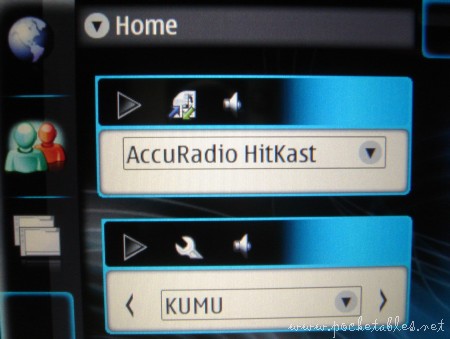
New audio streams can be added at will, radio stations can be saved and renamed, and FM reception (through headphones) is great. Sound quality varies depending on the source, but it’s generally on par with what you’d expect from an audio stream.
Rhapsody
In addition to Skype, the newest firmware added Rhapsody as a native application on the device.
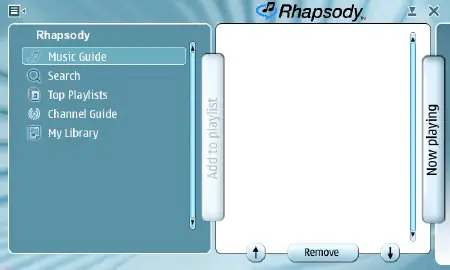
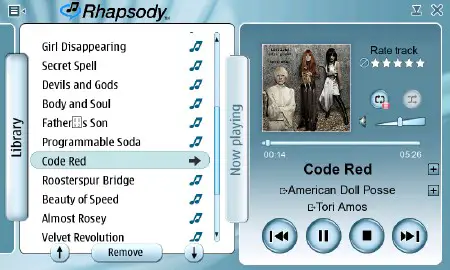
I don’t know if it was a limited-time offer, but a 30-day free trial account with Rhapsody Unlimited (normally $13/month) was included when I upgraded. I activated it without hesitation and thoroughly enjoyed a full month of full access to Rhapsody’s extensive music catalog.
The application crashed a few times when buffering chosen music, but the implementation on the N800 is still really nice. Tracks can be listened to throughout most of the system (web browsing included), and the interface is straightforward and clean.
I like the idea of having millions of songs at my disposal without giving up any space on my memory cards.
UPnP media server
The N800 can also act as a UPnP client, connecting to compatible media servers on the same wi-fi network to share multimedia content. I don’t normally store music or movies on my computer, but I installed Home Media Server on my Samsung Q1P so I could give the feature a try.
Music streamed with no problem (though the volume was very low), but video just stuttered and stuttered and stuttered. I’m sure there are workarounds and better apps than the one I tried, but I don’t care about the functionality enough to find out (I didn’t even have a media server installed before this!).
Productivity
When I called the N800 a full-featured Linux computer in Part 1 of this review, I wasn’t kidding.
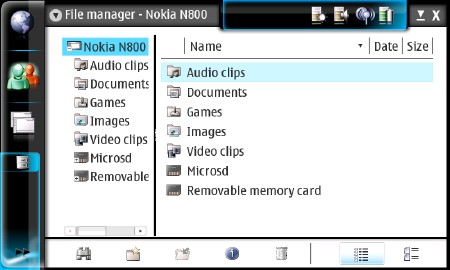
Aside from all the hacking and developing possibilities, the device is able to handle most basic computing tasks (word processing, file management, online apps, download/save images from the web, etc.) and can easily adapt to various work environments and usage scenarios.
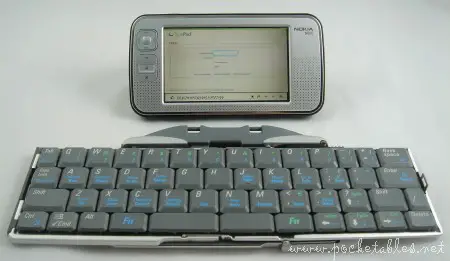
This flexibility is due in part to the integrated Bluetooth technology. The N800 supports the following profiles:
- Dial-up networking
- File transfer
- Generic access
- SIM access
- Object push
- Human interface device
- Serial port
Connected to my Think Outside (now iGo) Stowaway Universal Bluetooth keyboard, the unit allows me to do the majority of what I do online, including writing some of this review. If my iPhone supported Bluetooth DUN, the N800 would be one heck of a portable office and mobile blogging solution.
How productive you can be with the N800 depends on the nature of your work, of course, but the quick access to the internet, email, and contacts (where’s the calendar?) afforded by the device makes it possible to find a place in most lifestyles.
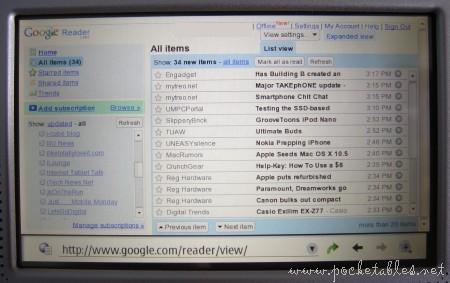

Keeping up with RSS feeds may not be a critical part of everyone’s workday, but I rely on it very heavily. The included reader is a nicely executed addition to the N800’s application list, but nothing can take me away from Google Reader.
Comfort
I’m incredibly grateful for the integrated desk stand, which I sometimes use as a hand strap, because the unit wasn’t designed with ergonomics in mind.
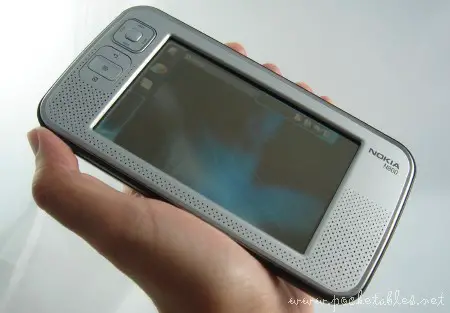
The device is relatively comfortable when used in both hands, but because I don’t like the hardware controls on the left of the display, I usually hold the device in one hand (my left) and the stylus in the other. Unfortunately, this is awkward and uncomfortable. Unlike in the picture above, the N800 can only be used in landscape mode, which requires some wrist contortion and a strong pinky to keep the device straight and steady.
The unit is light enough to be held in other ways ("pinched" between your thumb and other fingers, for example), but the pinky-centric one is what feels most natural to me. It’s the way I would imagine someone new to the device would pick it up and use it.
Battery life
I may be the only one who didn’t know this beforehand, but evidently the N800 is meant to be left on at all times. Not on-on, but idle-on like a cell phone. Even though I probably should’ve assumed this to be the case (it’s Nokia after all), I think a note about it should have been included in the user guide. Otherwise people like me are going to be pretty annoyed at the long boot-up time after a complete shutdown. A "full boot" takes about 40 seconds, whereas a "resume" from idle mode takes less than 1 second.
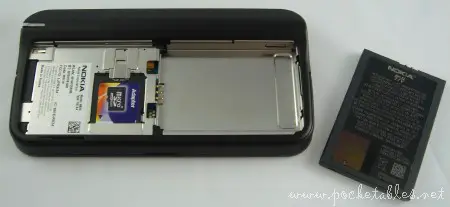
Anyway, the N800’s removable 1500mAh li-ion battery is given an "up to 13 days" standby estimate and an "up to 3.5 hours" web browsing time. How accurate these ratings are depends on various settings, but based on my daily usage patterns over the past six weeks, I’d say that the device requires a recharge every 2-3 days.
Conclusion
Although labeled as an internet tablet, the Nokia N800 really defies categorization. Web browsing on the device is certainly more enjoyable and desktop-like than almost anything else in its class (whatever that is), but that’s really just a fraction of what is truly a highly versatile, multi-faceted device. Beyond providing a rich internet experience, the N800 is an open-source Linux computer, mobile office, portable entertainment center, and communications tool.
Originally priced at $400, the Nokia N800 Internet Tablet is available now from Amazon for $280.

